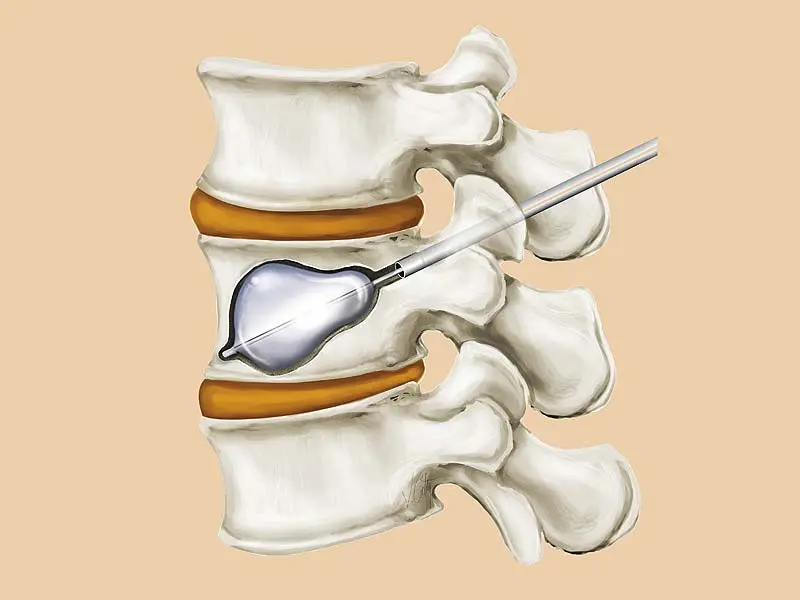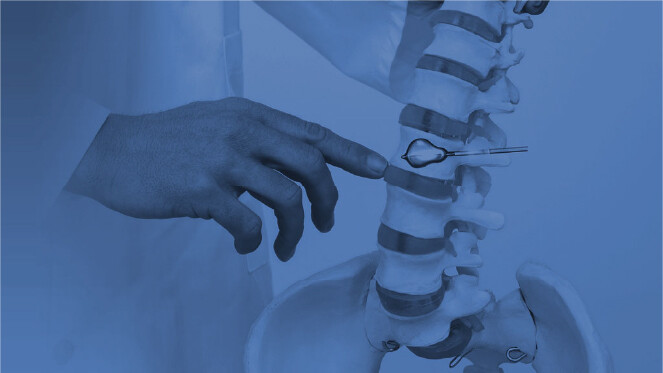Balloon Kyphoplasty
A minimally invasive spine procedure, kyphoplasty is used to treat compression fractures in the vertebrae. These fractures are usually caused by osteoporosis or trauma, can be very painful, and can cause the bones in the spine to collapse. This leads to kyphosis, a curve in the spine that makes you look hunched and can limit your breathing and much more rarely, the function of your internal organs. Kyphoplasty uses a balloon-like device to stabilise the fractured vertebrae, reduce pain, and restore spinal alignment, sometimes even restoring height. The balloon is used to create space within the fractured vertebra, and that space is filled with specialised bone cement.
Book a consultation
Who Needs Kyphoplasty?
Most of the time, vertical compression fractures (VCFs) are the result of osteoporosis. This disease causes bones to be more brittle, and more susceptible to vertebral compression fracture. However, that is not the only condition that can result in a break that requires kyphoplasty. Spinal trauma from an accident or fall can lead to compression fractures and certain cancers weaken the bones and lead to spinal fractures. Additionally, people who have been on steroid medications for long periods of time can sometimes experience bone weakening and vertebral fractures. In fact, there is research to indicate that the long-term use of prescribed steroids significantly increases the risk of nontraumatic vertebral fractures.
Sometimes, a person’s symptoms will indicate the need for kyphoplasty. If left untreated, these symptoms can lead to ongoing acute or chronic pain and other long-term complications. After sustaining a vertebral compression fracture, you may experience:
- Severe, sudden pain in the mid-back region.
- Limitation of spinal movement
- Pain that worsens when walking or when reclining first thing in bed at night.
- Loss of height.
- A rounded or hunched back.
How This Minimally Invasive Spine Procedure Works
It is natural to be concerned about having spinal surgery, but balloon kyphoplasty is straightforward and minimally invasive. It only takes about an hour to complete, and it is performed as a day case procedure, so you may be able to go home the same day. In many cases, the doctor likely prefers to keep the patient overnight, for observation and patient comfort. Here is a detailed look at how it works:
- The patient is given anaesthesia. Depending on several factors, including the complexity of the operation and the patient’s health, the anaesthesia will either be sedation or light general anaesthetic.
- The surgeon will insert a hollow needle, called a trocar, into the affected bone. This is done with the patient lying on his or her stomach whilst asleep, and the needle is guided by a fluoroscopy, which is a type of x-ray that shows the image in real time. A small balloon is then inserted through the needle and into the affected vertebra.
- The balloon is inflated. The surgeon carefully inflates the balloon to create space within the collapsed vertebra, in order to help realign the spine and potentially restore lost height. Once this is accomplished, the balloon is deflated and removed.
- The space created by the balloon is filled with special bone cement. Hardening quickly, this cement stabilises the vertebra and reduces the risk of further collapse. The cement forms a load sharing construct with the remaining normal bone and stops the fracture pain as a result.
- The needle is then removed. The place where the needle was inserted may require a stitch or adhesive, and will be covered with a dressing before the patient is discharged.
- The patient can usually go home the following day but may need a bit of assistance. First, a ride home from the clinic or hospital will be required. Then, because no strenuous activity should be undertaken after this procedure, help around the house may be necessary for the first day or two. Heavy housework or gardening should certainly be avoided for six weeks. No nursing care is needed, however.
What are the Benefits of Kyphoplasty?
Balloon kyphoplasty offers several key benefits, and is used in conjunction with osteoporosis treatment such as alendronate if needed, as well as for treating vertebral fractures from other causes. Here are a few of the benefits:
- Effective Pain Relief: Many patients experience significant relief from pain almost immediately, and others report pain relief within days or weeks (86% in many international research studies).
- Restoration of Spinal Height: By inflating the balloon, kyphoplasty can restore some of the lost height caused by vertebral compression fractures, helping to correct spinal deformities and reduce the risk of further kyphosis (hunching of the back).
- Minimally Invasive: The procedure is minimally invasive, and patients can typically go home the same or following day. There are fewer risks than there are with open surgery, such as infections or long recovery times. Indeed open surgery and fusion is contra-indicated in osteoporosis.
- Improved Mobility: With the spine stabilised and pain reduced, patients are better able to move freely and can resume daily activities fairly quickly after the procedure.
- Reduced Dependence on Pain Medication: By alleviating pain, kyphoplasty can reduce a patient’s reliance on strong painkillers, which can have unwanted side effects and lead to dependency.
- Quick Recovery Time: Most patients are able to return home quickly and resume light activities within a few days.
What are the Risks and Complications of Kyphoplasty?
As with any medical procedure, kyphoplasty carries some risks and potential complications. They are relatively rare, though, especially when compared to the risks associated with open surgery. It is important to discuss these risks with your healthcare provider, so that you can be proactive in recognising and understanding them.
- Infection: Any surgical procedure carries a risk of infection, though it is minimised with proper sterile techniques and antibiotics given during the operation.
- Bleeding: There may be a small risk of bleeding, especially in patients with certain medical conditions or those taking blood-thinning medications.
- Cement Leakage or extravasation: In rare cases, the bone cement may leak from the vertebra, which is often harmless and small in volume, but could cause nerve compression or affect nearby structures. This is much less common with the low-pressure injection ballon kyphoplasty technique (0.3% in most major studies).
- Adjacent level fracture: 7-14% of patients experience problems with a vertebra next to the affected one following successful surgery, particularly in osteoporosis. This is thought to be a combination of the underlying osteoporosis and the operated vertebra being stronger than it’s neighbours after cement implantation.
- Inadequate Pain Relief: While most patients experience significant pain relief, there are cases where the procedure does not fully resolve the back pain.
Preparation for Kyphoplasty
Before undergoing kyphoplasty, patients will undergo a thorough medical examination, including imaging tests like x-rays or MRIs. If you are a candidate for kyphoplasty, your surgeon may advise you to stop taking certain medications a few days before the procedure. These include but are not limited to blood thinners. Sometimes, patients are asked to fast for several hours before the procedure, especially if general anaesthesia will be required. Your healthcare provider will be able to more thoroughly explain these steps, and customise a plan tailored to meet your needs. When you go in for your kyphoplasty, you should wear loose, comfortable clothing, and no jewellery.
Recovery and Aftercare after Kyphoplasty?
One of the wonderful things about kyphoplasty is that recovery is quick, with minimal discomfort. After the kyphoplasty procedure, most patients can return home the next day. Before discharge, the patient will be monitored for a few hours to rule out immediate complications. Typically, patients can resume light activities within 48 hours, but strenuous activities, bending, and heavy lifting should be avoided for a few weeks.

Patient Considerations
The ideal candidate for balloon kyphoplasty is someone who has been diagnosed with a recent vertebral compression fracture through medical examination and imaging tests. This person will have moderate to severe pain at the site of the fracture, which has not improved with other, more conservative treatments such as painkillers. However, for a patient to be a good candidate, he or she must also be in reasonable overall health, able to tolerate the procedure and the anaesthesia. Here are some common questions and concerns among kyphoplasty patients:
- Will the procedure hurt? Most patients experience minimal discomfort during the procedure, thanks to sedation or light general anaesthesia.
- How long does the procedure take? Kyphoplasty typically takes about 30 to 60 minutes per vertebra, and patients can often return home the next day.
- When will I feel relief? Many patients feel significant pain relief within days of the procedure, with some noticing improvement almost immediately.
- How effective is kyphoplasty? The success rate of kyphoplasty is about 86 percent in our practice, in line with international success rates, with that number of patients reporting better pain relief after the procedure.
- When can I return to my normal activities? Most people are able to return to their daily routine once the anaesthetic has worn off from kyphoplasty. However, it is important to avoid strenuous exercises for several weeks after the procedure.
- Are there any symptoms that warrant a call to the doctor? You should reach out to your healthcare provider straight away if you experience any signs of infection, like a fever, swelling, or changes in skin colour. Other symptoms that warrant contacting the doctor include excess bleeding, numbness or tingling, or worsening pain.
- Is there anything I can do to prevent future fractures? Maintaining a nutrient-dense diet with a focus on calcium and vitamin D can help strengthen your bones and prevent further bone loss. Low-impact exercises can improve bone density and strengthen muscles. Avoid tobacco and alcohol use, as these can contribute to weakened bones. Keep all follow-up appointments, as well as regular check-ups with your healthcare provider.
What is the cost of the procedure?
SpineArt fees due at the point of booking
Balloon Kyphoplasty
This is a modified vertebroplasty technique. It is a minimally invasive procedure that aims to relieve pain, restore vertebral height, and correct kyphosis.
£17,421*
Want to talk to someone or book an appointment?
If your still unsure and have any questions, contact our receptionist Bev on 07539 330360 to arrange a consultation with Dan Fagan or email us at secretary@spineart.org.
Get in touch Book a consultation







